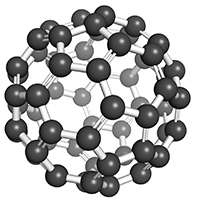Zhichuan (Jason) Xu, PhD, FRSC
Professor
School of Materials Science and Engineering
Nanyang Technological University, Singapore
Date: December 15, 2021
Time: 1000h ET
Sponsor: Hiden Analytical
Zhichuan (Jason) Xu, PhD, FRSC
Professor
School of Materials Science and Engineering
Nanyang Technological University, Singapore
Date: December 15, 2021
Time: 1000h ET
Sponsor: Hiden Analytical
 Robert Wong, proprietor of SES Research Inc., is proud to announce a new and exciting materials grant to support researchers whose projects focus on Carbon 60 powder. Through this, researchers can obtain C60—at little or no cost—for their investigations.
Robert Wong, proprietor of SES Research Inc., is proud to announce a new and exciting materials grant to support researchers whose projects focus on Carbon 60 powder. Through this, researchers can obtain C60—at little or no cost—for their investigations.
According to the Federal Aviation Administration, nearly 7,000 laser strikes on aircrafts were reported in 2017.
“In cities like Chicago this problem is real as people are shining laser pointers on aircrafts during critical phases of flight, which is a big nuisance to pilots,” said Jason Keleher, a professor and chair of chemistry at Lewis University, who was approached by the aviation department at Lewis University to collaborate on a solution to this growing problem .
“Is it a bunch of kids? Is it accidental? Is somebody just like, ‘I bet you can’t hit that plane with those lasers.’ It’s really hard to identify who’s actually doing it. It’s a very interesting problem,” said Keleher, one he, the project’s principal investigator, was prepared to solve.
Keleher explains that although the lasers don’t cause permanent eye damage to pilots as they maneuver the aircraft, it does cause temporary flash blindness which may make it difficult for pilots to see control systems as they prepare for take-off and landing. He explains it is similar to the way high beams can disorient a driver upon direct exposure.
(more…)
According to Forbes, engineers at the University of Colorado Boulder have created a new material that works like an air conditioning system for structures—cooling rooftops with zero energy consumption.
The material, about the same thickness as aluminum foil, is rolled across the surface of a rooftop, reflecting incoming solar energy back into space while simultaneously purging its own heat. Adding to its appeal, the material is adaptable and cost-effective for use in large-scale residential and commercial applications, as it can be manufactured on rolls. (more…)

Gerald Frankel, a technical editor of the Journal of The Electrochemical Society, corrosion expert, and open access advocate.
The aftereffects of the Flint water crisis is still felt strongly four years later. Just this year, dozens of Flint, Michigan, residents were outraged by the state’s decision to end a free bottled water program. A program that came into effect after it was discovered the water in Flint was unsafe for consumption.
The catastrophe came to fruition when measures were taken by elected officials to cut costs. The result of which led to tainted drinking water that contained lead and other toxins.
Gerald Frankel, a professor of materials science and engineering at The Ohio State University, touched on the matter in an ECS Podcast interview.
“It was avoidable,” says Frankel, who explained that because water is corrosive, drinking water is treated to reduce the corrosive effects on the pipes that carry it. However, due to financial issues the town of Flint was facing, their source of the water changed from Lake Michigan to the Flint River. “And they decided not to do this chemical treatment.”
Artificial limbs have experience tremendous evolution in their long history. Throughout history, we’ve gone from the peg leg of the Dark Ages to technologically advanced modern day prosthesis that mimic the function of a natural limb. However, most prosthesis still lack a sense of touch.
Zhenan Bao, past ECS member and chemical engineer at Stanford University, is at the forefront of the research looking to change that.
(MORE: Read Bao’s past meeting abstracts in the ECS Digital Library for free.)
Recently on NPR’s All Things Considered, Bao described her work in developing a plastic artificial skin that can essentially do all the things organic skin can do, including sensing and self-healing.
The self-healing plastic Bao uses mimics the electrical properties of silicon and contains a nano-scale pressure sensor. The sensor is then connected to electrical circuits that connect to the brain, transmitting the pressure to the brain to analyze as feeling.
Additionally, the skin is set to be powered by polymers that can turn light into electricity.
While there is still much work to be done, Bao and her colleagues believe that this product could help people who have lost their limbs regain their sense of touch.